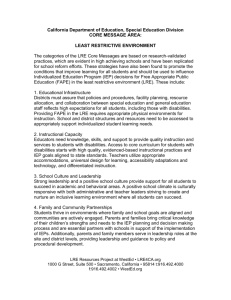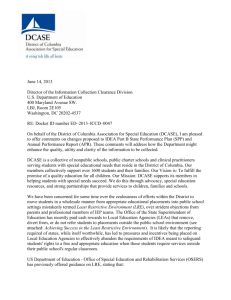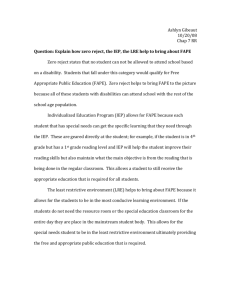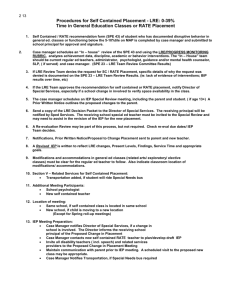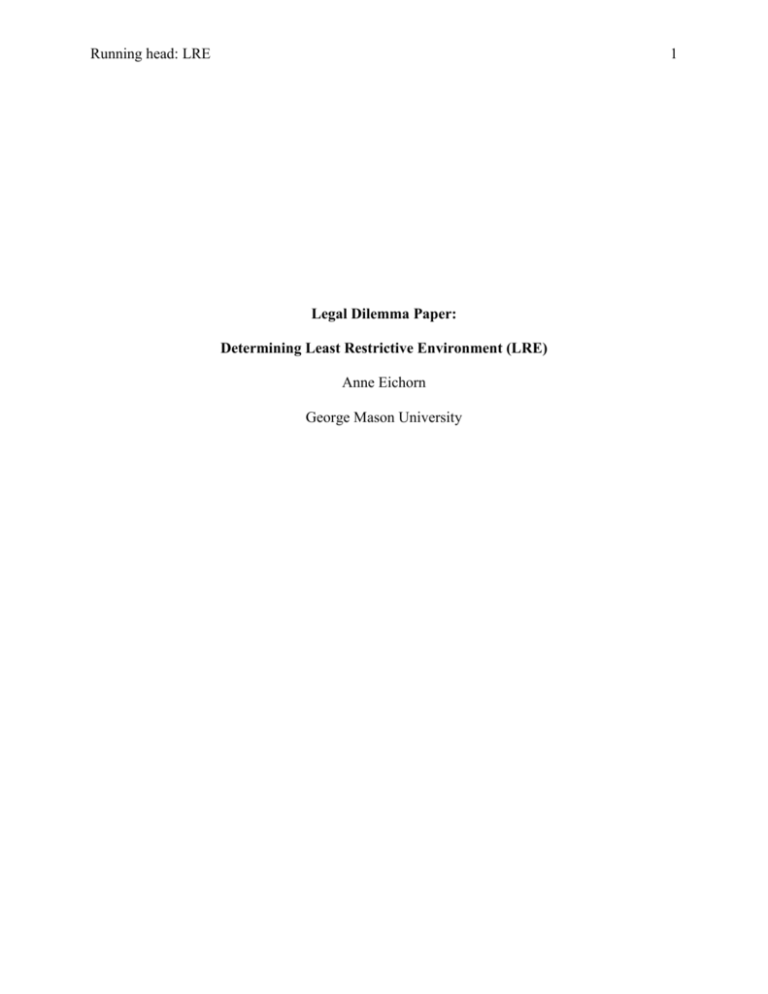
Running head: LRE
1
Legal Dilemma Paper:
Determining Least Restrictive Environment (LRE)
Anne Eichorn
George Mason University
Running head: LRE
2
Legal Dilemma in Special Education
I interviewed our school psychologist (S.R) regarding M.N., a student I had taught 2
years ago for 7th grade intensive Math and Science. As a special educator in the same building, I
have a good relationship with S.R. and we often communicate regarding the academic and
behavioral progress of our students with disabilities. M.N.’s parents hired an advocate towards
the end of his 8th grade year and began challenging the issue of their son not having made any
reading progress; possibly to arrive at the point that their son belonged in a nonpublic private
setting for his needs.
M.N. is currently a 16 year old 9th grader at his neighborhood high school, and is
currently receiving special education services in intensive resource classes as a student who is
Other Health Impaired; with reading interventions in place as recommended by his middle
school IEP team, in June before his 9th grade year. M.N. has been receiving services since
kindergarten when he was first evaluated. Over time assessments have shown that M.N.’s verbal
abilities are significantly less when compared to his nonverbal visual/processing abilities. He
also has a history of ADHD symptoms, executive function, and emotional stressors for which he
is currently under medical treatment.
When S.R. agreed to update me on the background and status of this particular LRE
(least restrictive environment) case, I wasn’t too aware of the student upon entering our middle
school towards the end of his 7th grade year. It’s the perspective of S.R. (our psychologist) that
M.N. is academically low now due to both the lack of parent involvement when he lived with his
birth mother before entering our school, and his significant attendance problems. When he
moved in with his real father and stepmother and began attending our school in his 7th grade
year, they were concerned that M.N was still reading at least 3-4 years below grade level
Running head: LRE
3
expectations. M.N. was seen as a capable student by his teachers, however, the stepmother
wanted gaps to be filled and the home situation was now more structured. Between academic
demands and a stricter home environment the student had to make significant adjustments and
about a year later the family worked with an advocate to ensure M.N. received what they felt he
was entitled to. At this time the parents also seemed apprehensive about their son’s intensive
placement in the neighborhood public high school. It was evident that behavior concerns were
also developing; although, it was perceived by school staff that the change may have been due to
the stepmom telling M.N. to act up and stop doing work so that more services could be attained.
The reevaluation took place towards the end of his 8th grade year before high school and the
advocate requested updated testing as the memory and auditory processing problems hadn’t been
defined in earlier assessments. The advovate was in communication with the psychologist before
the results were read as they were concerned how influential her test could possibly be in
determining disability category and LRE. One recommendation from the updated psychological
was that M.N. would benefit from a structured reading program, as the attention weaknesses he
demonstrated seemed to directly affect his reading comprehension. The action plan according to
this recommendation was to arrange for reading intervention classes in high school, and then
meet after 30 days if there was not progress. Apparently the advocate was not satisfied with this
result as they intended to pursue private placement, however, the team needed to put
interventions in place first to honor the LRE mandate. The advocate actually emailed the
psychologist asking why S.R. kept quiet in the meeting when she said off record that “the student
probably wouldn’t do well in that school and he needs ESY (Extended School Year).” S.R.
directed the advocate’s email to the county compliance officer for assistance and made no further
contact with the advocate.
Running head: LRE
4
The family and advocate kept quiet the summer before high school, and another meeting
was held in 9th grade focusing on safety because the student was involved in a fight at the
beginning of the school year. It was reported that the student was currently making reading
progress in Read 180; however, M.N.’s refusal regarding work completion began again in high
school. In addition, the student was quiet when the high school psychologist met with him the
one time that he was permitted to through the family and advocate.
A due process hearing was scheduled for April of this school year (2010). The focus was
the 8th grade psychologist report because the recommended areas didn’t improve according to the
family/advocate of M.N. In the hearing, the off the record statements made by our psychologist,
in communicating with the advocate, were used to the advocate’s advantage. S.R. the
psychologist contacted the county attorney after she received the hearing notice because she was
going to be a witness. As a result of the meeting, the CIEP (Central Individualized Education
Program Team) leader was going to observe the student in high school and make
recommendations.
Legal Implications of the Dilemma
The FAPE (Free and Appropriate Public Education) and LRE requirements of the
Individuals with Disabilities Education Act (IDEA) are interrelated. LRE refers to the relative
restrictiveness of the setting in which a student with disabilities is educated. The preferred
environment is as close to the general education environment as is appropriate. Depending on
what the special education services and IEP team determines to be required for students to
receive a FAPE; however the LRE may be more restrictive than the general education classroom
(Yell, 2006). In determining placement, the IEP team balances FAPE with the preference for
Running head: LRE
5
educating students with disabilities with their peers in the general education classroom. The
team selects the most integrated setting that is compatible with the delivery of an appropriate
education; that setting is the LRE. The IDEA appears unambiguous regarding LRE; The IEP
team is to determine the setting with the greatest degree of integration in which an appropriate
education is available. The IEP team must make the placement decision based on the student’s
IEP, determine placement at least annually, and placement must be made in conformity with the
LRE requirement of IDEA (IDEA regulations, 34, C.F.R. §300.552 (a) (2,1,4) ).
At the core of IDEA is a requirement that indicates that students with disabilities are to be
educated “… to the maximum extent appropriate … with children who are nondisabled; and …
Special classes, separate schooling, or other removal of children with disabilities from the
regular educational environment occurs only if the nature or severity of the disability is such that
education in regular classes with the use of supplementary aids and services cannot be achieved
satisfactorily” (20 U.S.C. § 300.114 (a)). This LRE mandate ensures that every school which
accepts federal funding educates students with disabilities in settings with students without
disabilities to the maximum extent appropriate. Furthermore, it is only when a free and
appropriate public education (FAPE) cannot be provided, even with supplementary aides and
services; that students with disabilities may be placed in more restrictive environments other than
the general education setting (Yell, 2006).
The landmark court case involving FAPE, which related to the LRE issue being
discussed, is Hendrick Hudson School District v. Rowley in 1982 with the Supreme Court’s
decision that interpreted the FAPE mandate under IDEA. The Supreme Court considered the
meaning of FAPE and developed a two-part test in determining appropriate placements for
students with disabilities. The test questions whether the school complied with the procedures of
Running head: LRE
6
instruction designed to meet the unique needs of students with disabilities supported by such
services as needed to permit the student to benefit from instruction, and whether the education
program was reasonably calculated to allow the child to receive educational benefits. The
Supreme Court ruled that the student with disabilities was entitled to an education that is
reasonably calculated to confer educational benefit, not the “best” benefit (Yell, 2006).
Another related case relevant to M.N.’s placement issue is D. v. Board of Education of
Aptakisic-Tripp Community Consolidated School District (2009), which evaluated the decision
of whether FAPE under IDEA was denied to a student when the student was not placed in a more
restrictive environment. This is similar to M.N.’s case in terms of the parents pursuing a more
restrictive setting. The parents unilaterally enrolled their daughter, Sarah, in a private school and
claimed the district had denied the student a free, appropriate public education. They were
unsuccessful in gaining reimbursement for the private school placement as they failed to show
that the district’s IEP was inappropriate. Also relating to my case as a possible outcome, the
student’s current elementary school was found to be the least restrictive environment, as it was
reasonably calculated to enable to child to receive educational benefit.
The case of J.D v. New York City D.O.E. (2008) additionally had similarities to my case
in review as it questioned whether FAPE under IDEA was denied to a student when the student
was not placed in a more restrictive environment. The parent challenged the IEP indicating that
the IEP did not provide the student with a free appropriate public education in the least restrictive
environment, when compared to a certain private program. The mother had unilaterally placed
the student in this private program, which was attended by only students with disabilities. She
was granted reimbursement for her son’s attendance to the private school for the disputed year,
and a motion for summary judgment. This issue potentially connects to M.N.’s case as evidence
Running head: LRE
7
from the J.D.’s mother demonstrated that the desired private setting was reasonably calculated to
enable the child to receive educational benefit.
Actual Outcome of Legal Dilemma
The legal conflict involving M.N. has not been resolved yet as we are waiting to hear the
recommendation of the CIEP leader. However, if the team denies nonpublic after the
observation; due process will likely occur again. Another potential result would be that it would
cost the school system $60,000 a year to send the child to the nonpublic school.
Suggestions for Resolution and Implications for Practice
Because of the individualized nature of the LRE placement, there are no simple rules to
guide IEP teams in making placement decisions. The legislation and litigation do, however,
provide guidance regarding the decision-making process. The IEP must be developed before a
placement decision, and the IEP team and other qualified personnel should determine placement
of students with disabilities. IDEA presumes that students will participate with non-disabled
students in the general education settings; if not, the IEP needs to explain why. In determining
placement, the IEP team should consider the following factors: whether the proposed program is
appropriate for the student, be sure the entire continuum of placements is available if needed,
place the student in his/her home school if appropriate, and educate with nondisabled students to
the maximum extent possible. School district decisions should also be based on formative date
collected throughout the LRE process including what interventions were attempted, and how
many were implemented (Yell, 2006).
Running head: LRE
8
In conclusion, it’s essential to have ongoing communication with parents and provide
information to the parents about progress as well as change of placement decisions. Placement
decisions have evolved as a result of recent cases, as we witness an increase in advocates of
disabled children taking place with the intent of ensuring the least restrictive environment (LRE).
IEP team members also need to maintain an ethical stance when necessary because they know
what setting is best for their students, and it may go beyond administrative holdings.
Running head: LRE
9
References
Board of Education of the Hendrick Hudson School District v. Rowley , 458 U.S. 176 (1982).
Individuals with Disabilities Education Improvement Act, 20 U.S.C. §1400 (2004).
James and Lee Anne D. v. Board of Education of Aptakisic-Tripp Community Consolidated
School District No. 102 (2009), 642 F.2d, 804.
Jennifer D. v. New York Department of Education (2008) 550, F2d, 420.
Yell, M.L. (2006). The law and special education (2nd ed.). Upper Saddle River, NJ: Pearson,
Prentice Hall.

